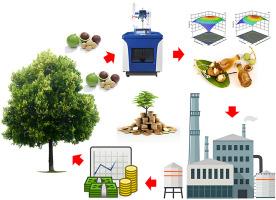Optimization, simulation and techno-economic studies of microwave-assisted oil extraction from Calophyllum inophyllum L. kernels
IF 3.8
Q2 BIOTECHNOLOGY & APPLIED MICROBIOLOGY
引用次数: 0
Abstract
This study focused on optimizing and evaluating the efficiency of oil extraction from Calophyllum inophyllum L. kernels using hexane as the solvent through microwave-assisted extraction. The process was systematically studied using a central composite design under response surface methodology to determine the influence of three key parameters solvent: seed kernel (v/w) ratio, extraction temperature, and extraction time. Optimal conditions were identified as a solvent: kernel (v/w) ratio of 15.92 mL/g, a temperature of 39.95 °C, and an extraction time of 26.64 min, achieving a maximum oil yield of 68.76 %. Analysis of variance confirmed that the solvent: kernel (v/w) ratio and extraction time were significant factors affecting the oil yield. Chemical profiling of the extracted oil via gas chromatography-mass spectrometry revealed oleic acid (C18:1) as the predominant fatty acid, emphasizing the oil potential for various industrial applications. Kinetic studies established that the extraction process followed a first-order reaction with an activation energy of 44.62 kJ/mol. To evaluate scalability, a plant simulation was developed using the Aspen Plus software, with economic modeling performed using Aspen Process Economic Analyzer, and revealed that the oil selling price was the most critical parameter influencing profitability. Financial assessment indicated the process viability, with a net present value of $4,246,890, an internal rate of return of 15.65 %, and a payback period of 8.01 years. These findings highlight the feasibility and economic potential of MAE for Calophyllum inophyllum L. oil (CLO) extraction on an industrial scale.

微波辅助榨油工艺优化、模拟及技术经济研究
研究了以己烷为溶剂,微波辅助萃取法提取花椒籽粒油的工艺条件。采用响应面法的中心组合设计对提取工艺进行了系统研究,确定了溶剂:种核比(v/w)、提取温度和提取时间三个关键参数对提取工艺的影响。最佳提取条件为:仁(v/w)比为15.92 mL/g,提取温度为39.95℃,提取时间为26.64 min,提取率为68.76%。方差分析证实,溶剂:核液(v/w)比和提取时间是影响油得率的重要因素。经气相色谱-质谱联用分析,发现油酸(C18:1)为主要脂肪酸,具有广泛的工业应用潜力。动力学研究表明,萃取过程为一级反应,活化能为44.62 kJ/mol。为了评估可扩展性,使用Aspen Plus软件开发了一个工厂模拟,并使用Aspen Process economic Analyzer进行了经济建模,结果表明石油销售价格是影响盈利能力的最关键参数。财务评估表明该过程可行,净现值为4,246,890美元,内部收益率为15.65%,投资回收期为8.01年。这些研究结果表明,在工业规模上利用MAE提取花椒油(CLO)的可行性和经济潜力。
本文章由计算机程序翻译,如有差异,请以英文原文为准。
求助全文
约1分钟内获得全文
求助全文
来源期刊

Biocatalysis and agricultural biotechnology
Agricultural and Biological Sciences-Agronomy and Crop Science
CiteScore
7.70
自引率
2.50%
发文量
308
审稿时长
48 days
期刊介绍:
Biocatalysis and Agricultural Biotechnology is the official journal of the International Society of Biocatalysis and Agricultural Biotechnology (ISBAB). The journal publishes high quality articles especially in the science and technology of biocatalysis, bioprocesses, agricultural biotechnology, biomedical biotechnology, and, if appropriate, from other related areas of biotechnology. The journal will publish peer-reviewed basic and applied research papers, authoritative reviews, and feature articles. The scope of the journal encompasses the research, industrial, and commercial aspects of biotechnology, including the areas of: biocatalysis; bioprocesses; food and agriculture; genetic engineering; molecular biology; healthcare and pharmaceuticals; biofuels; genomics; nanotechnology; environment and biodiversity; and bioremediation.
 求助内容:
求助内容: 应助结果提醒方式:
应助结果提醒方式:


